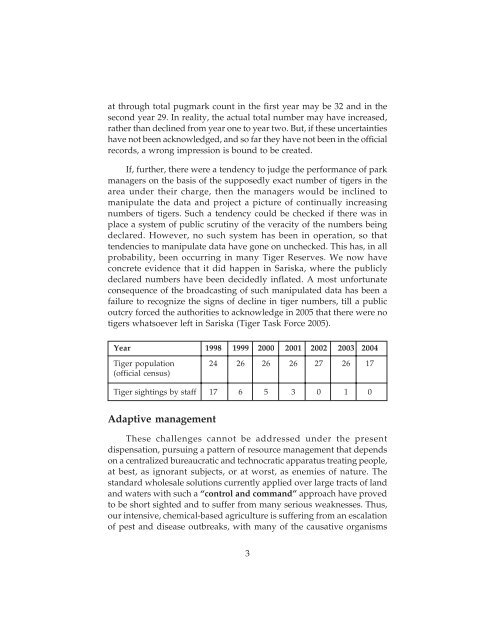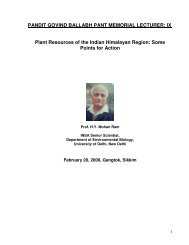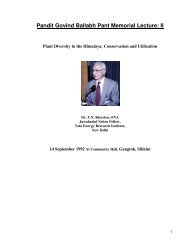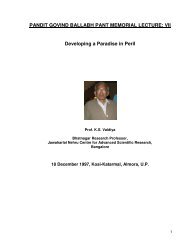Pt. Govind Ballabh Pant Memorial Lecture : XI
Pt. Govind Ballabh Pant Memorial Lecture : XI
Pt. Govind Ballabh Pant Memorial Lecture : XI
- No tags were found...
You also want an ePaper? Increase the reach of your titles
YUMPU automatically turns print PDFs into web optimized ePapers that Google loves.
at through total pugmark count in the first year may be 32 and in thesecond year 29. In reality, the actual total number may have increased,rather than declined from year one to year two. But, if these uncertaintieshave not been acknowledged, and so far they have not been in the officialrecords, a wrong impression is bound to be created.If, further, there were a tendency to judge the performance of parkmanagers on the basis of the supposedly exact number of tigers in thearea under their charge, then the managers would be inclined tomanipulate the data and project a picture of continually increasingnumbers of tigers. Such a tendency could be checked if there was inplace a system of public scrutiny of the veracity of the numbers beingdeclared. However, no such system has been in operation, so thattendencies to manipulate data have gone on unchecked. This has, in allprobability, been occurring in many Tiger Reserves. We now haveconcrete evidence that it did happen in Sariska, where the publiclydeclared numbers have been decidedly inflated. A most unfortunateconsequence of the broadcasting of such manipulated data has been afailure to recognize the signs of decline in tiger numbers, till a publicoutcry forced the authorities to acknowledge in 2005 that there were notigers whatsoever left in Sariska (Tiger Task Force 2005).Year 1998 1999 2000 2001 2002 2003 2004Tiger population 24 26 26 26 27 26 17(official census)Tiger sightings by staff 17 6 5 3 0 1 0Adaptive managementThese challenges cannot be addressed under the presentdispensation, pursuing a pattern of resource management that dependson a centralized bureaucratic and technocratic apparatus treating people,at best, as ignorant subjects, or at worst, as enemies of nature. Thestandard wholesale solutions currently applied over large tracts of landand waters with such a “control and command” approach have provedto be short sighted and to suffer from many serious weaknesses. Thus,our intensive, chemical-based agriculture is suffering from an escalationof pest and disease outbreaks, with many of the causative organisms3











